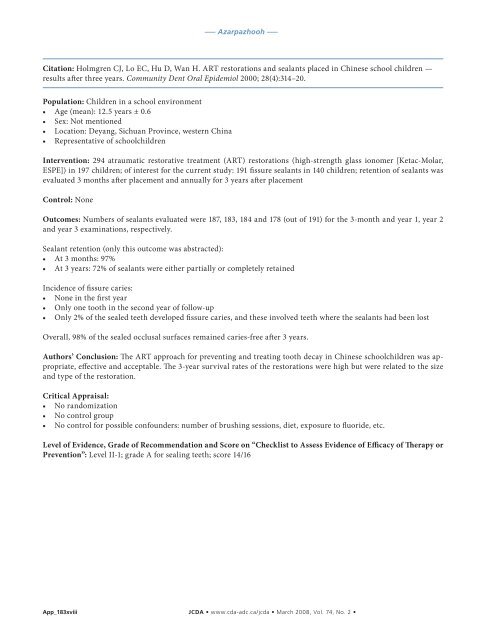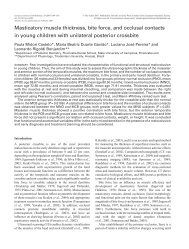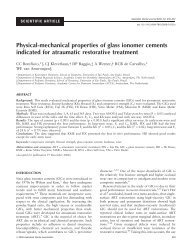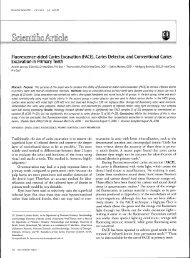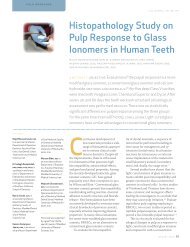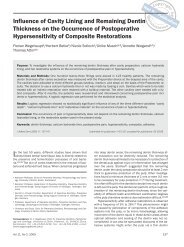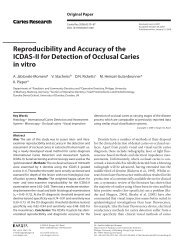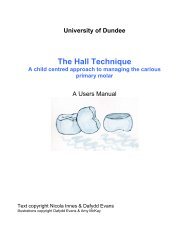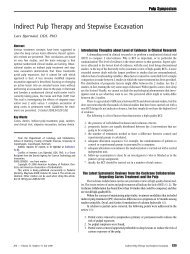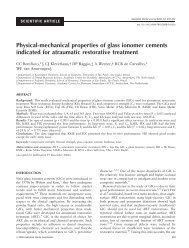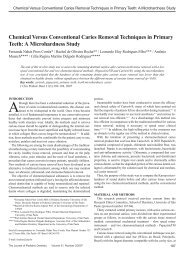Pit and Fissure Sealants in the Prevention of Dental Caries in ...
Pit and Fissure Sealants in the Prevention of Dental Caries in ...
Pit and Fissure Sealants in the Prevention of Dental Caries in ...
Create successful ePaper yourself
Turn your PDF publications into a flip-book with our unique Google optimized e-Paper software.
––– Azarpazhooh –––<br />
Citation: Holmgren CJ, Lo EC, Hu D, Wan H. ART restorations <strong>and</strong> sealants placed <strong>in</strong> Ch<strong>in</strong>ese school children —<br />
results after three years. Community Dent Oral Epidemiol 2000; 28(4):314–20.<br />
Population: Children <strong>in</strong> a school environment<br />
• Age (mean): 12.5 years ± 0.6<br />
• Sex: Not mentioned<br />
• Location: Deyang, Sichuan Prov<strong>in</strong>ce, western Ch<strong>in</strong>a<br />
• Representative <strong>of</strong> schoolchildren<br />
Intervention: 294 atraumatic restorative treatment (ART) restorations (high-strength glass ionomer [Ketac-Molar,<br />
ESPE]) <strong>in</strong> 197 children; <strong>of</strong> <strong>in</strong>terest for <strong>the</strong> current study: 191 fissure sealants <strong>in</strong> 140 children; retention <strong>of</strong> sealants was<br />
evaluated 3 months after placement <strong>and</strong> annually for 3 years after placement<br />
Control: None<br />
Outcomes: Numbers <strong>of</strong> sealants evaluated were 187, 183, 184 <strong>and</strong> 178 (out <strong>of</strong> 191) for <strong>the</strong> 3-month <strong>and</strong> year 1, year 2<br />
<strong>and</strong> year 3 exam<strong>in</strong>ations, respectively.<br />
Sealant retention (only this outcome was abstracted):<br />
• At 3 months: 97%<br />
• At 3 years: 72% <strong>of</strong> sealants were ei<strong>the</strong>r partially or completely reta<strong>in</strong>ed<br />
Incidence <strong>of</strong> fissure caries:<br />
• None <strong>in</strong> <strong>the</strong> first year<br />
• Only one tooth <strong>in</strong> <strong>the</strong> second year <strong>of</strong> follow-up<br />
• Only 2% <strong>of</strong> <strong>the</strong> sealed teeth developed fissure caries, <strong>and</strong> <strong>the</strong>se <strong>in</strong>volved teeth where <strong>the</strong> sealants had been lost<br />
Overall, 98% <strong>of</strong> <strong>the</strong> sealed occlusal surfaces rema<strong>in</strong>ed caries-free after 3 years.<br />
Authors’ Conclusion: The ART approach for prevent<strong>in</strong>g <strong>and</strong> treat<strong>in</strong>g tooth decay <strong>in</strong> Ch<strong>in</strong>ese schoolchildren was appropriate,<br />
effective <strong>and</strong> acceptable. The 3-year survival rates <strong>of</strong> <strong>the</strong> restorations were high but were related to <strong>the</strong> size<br />
<strong>and</strong> type <strong>of</strong> <strong>the</strong> restoration.<br />
Critical Appraisal:<br />
• No r<strong>and</strong>omization<br />
• No control group<br />
• No control for possible confounders: number <strong>of</strong> brush<strong>in</strong>g sessions, diet, exposure to fluoride, etc.<br />
Level <strong>of</strong> Evidence, Grade <strong>of</strong> Recommendation <strong>and</strong> Score on “Checklist to Assess Evidence <strong>of</strong> Efficacy <strong>of</strong> Therapy or<br />
<strong>Prevention</strong>”: Level II-1; grade A for seal<strong>in</strong>g teeth; score 14/16<br />
App_183xviii<br />
JCDA • www.cda-adc.ca/jcda • March 2008, Vol. 74, No. 2 •


